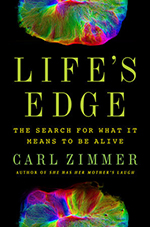17 January 2023
Life’s Edge, by Carl Zimmer
Posted by Callan Bentley
 Carl Zimmer is a veteran science writer, a journalist who has been pumping out terrific popular natural history explorations for decades now. His latest explores the marginal zone between living and nonliving: Life’s Edge. I found it to be an interesting and enjoyable volume, entirely as I’ve come to expect from Zimmer. Biology is a science with an interesting conundrum at its heart – it’s not totally clear what qualifies as life. Various definitions have been proposed, but none of them is perfect. As a result, various practitioners employ different working definitions of life. The panoply of definitions share certain hallmarks, and Zimmer explores these hallmarks over the course of the book: homeostasis, metabolism, boundaries, reproduction, evolution. To me, this gets most interesting when the topic is the origins of life on this planet, but Zimmer also covers issues related to the cessation of life (death) in humans: brain-dead patients whose hearts still beat while machines move their lungs for them. And abortion gets some page-space too, in regard to the eternal question of when a human life can be said to begin. Laboratory experiments get descriptions in loving detail: the weirdness of “radiobes” and mobile drops of oil, David Deamer’s experiments with drying and re-wetting lipids as a plausible mechanism to organize the RNA World. A particularly odd experiment uses cells from human brains to make little blobs that can communicate electrically with their neighbors. But are they “alive”? What about red blood cells? They lack DNA and don’t reproduce, but at least have a metabolism. Viruses have DNA (or RNA) and reproduce, but cannot do it without hijacking an external cell. This pattern is duplicated in some fish: they essentially clone themselves, but require mating with another fish to start the process, even though none of the mate’s DNA is utilized or expressed. Wild anecdotes from the fringes of bread-and-butter biology! Each chapter is essentially a stand-alone science essay, but with enough connective tissue and references to previously covered characters and concepts that it feels cohesive as a book. Pretty interesting stuff.
Carl Zimmer is a veteran science writer, a journalist who has been pumping out terrific popular natural history explorations for decades now. His latest explores the marginal zone between living and nonliving: Life’s Edge. I found it to be an interesting and enjoyable volume, entirely as I’ve come to expect from Zimmer. Biology is a science with an interesting conundrum at its heart – it’s not totally clear what qualifies as life. Various definitions have been proposed, but none of them is perfect. As a result, various practitioners employ different working definitions of life. The panoply of definitions share certain hallmarks, and Zimmer explores these hallmarks over the course of the book: homeostasis, metabolism, boundaries, reproduction, evolution. To me, this gets most interesting when the topic is the origins of life on this planet, but Zimmer also covers issues related to the cessation of life (death) in humans: brain-dead patients whose hearts still beat while machines move their lungs for them. And abortion gets some page-space too, in regard to the eternal question of when a human life can be said to begin. Laboratory experiments get descriptions in loving detail: the weirdness of “radiobes” and mobile drops of oil, David Deamer’s experiments with drying and re-wetting lipids as a plausible mechanism to organize the RNA World. A particularly odd experiment uses cells from human brains to make little blobs that can communicate electrically with their neighbors. But are they “alive”? What about red blood cells? They lack DNA and don’t reproduce, but at least have a metabolism. Viruses have DNA (or RNA) and reproduce, but cannot do it without hijacking an external cell. This pattern is duplicated in some fish: they essentially clone themselves, but require mating with another fish to start the process, even though none of the mate’s DNA is utilized or expressed. Wild anecdotes from the fringes of bread-and-butter biology! Each chapter is essentially a stand-alone science essay, but with enough connective tissue and references to previously covered characters and concepts that it feels cohesive as a book. Pretty interesting stuff.


 Callan Bentley is Associate Professor of Geology at Piedmont Virginia Community College in Charlottesville, Virginia. He is a Fellow of the Geological Society of America. For his work on this blog, the National Association of Geoscience Teachers recognized him with the James Shea Award. He has also won the Outstanding Faculty Award from the State Council on Higher Education in Virginia, and the Biggs Award for Excellence in Geoscience Teaching from the Geoscience Education Division of the Geological Society of America. In previous years, Callan served as a contributing editor at EARTH magazine, President of the Geological Society of Washington and President the Geo2YC division of NAGT.
Callan Bentley is Associate Professor of Geology at Piedmont Virginia Community College in Charlottesville, Virginia. He is a Fellow of the Geological Society of America. For his work on this blog, the National Association of Geoscience Teachers recognized him with the James Shea Award. He has also won the Outstanding Faculty Award from the State Council on Higher Education in Virginia, and the Biggs Award for Excellence in Geoscience Teaching from the Geoscience Education Division of the Geological Society of America. In previous years, Callan served as a contributing editor at EARTH magazine, President of the Geological Society of Washington and President the Geo2YC division of NAGT.